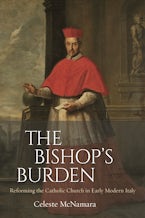Preparing your PDF for download...
There was a problem with your download, please contact the server administrator.
The Bishop's Burden
Reforming the Catholic Church in Early Modern Italy
Imprint: Catholic University of America Press
In 1563, the Council of Trent published its Decrees, calling for significant reforms of the Catholic Church in response to criticism from both Protestants and Catholics alike. Bishops, according to the Decrees, would take the lead in implementing these reforms. They were tasked with creating a Church in which priests and laity were well educated, morally upright, and focused on worshipping God. Unfortunately for these bishops, the Decrees provided few practical suggestions for achieving the wide-ranging changes demanded. Reform was therefore an arduous and complex process, which many bishops struggled to accomplish or even refused to undertake fully.
The Bishop’s Burden argues that reforming bishops were forced to be creative and resourceful to accomplish meaningful change, including creating strong diocesan governments, reforming clerical and lay behavior, educating priests and parishioners, and converting non-believers. The book explores this issue through a detailed case study of the episcopacy of Cardinal-Bishop Gregorio Barbarigo of Padua (bp. 1664-1697), asking how a dedicated bishop formulated a reform program that sought to achieve the Church’s goals. Barbarigo, like other reforming bishops, borrowed strategies from a variety of sources in the absence of clear guidance from Rome. He looked to both pre- and post-Tridentine bishops, the Society of Jesus, the Venetian government, and the Propaganda Fide, which he selectively emulated to address the problems he discovered in Padua. The book is based primarily on the detailed records of Barbarigo’s visitations of rural parishes and captures the rarely-heard voices of seventeenth-century Italian peasants.
The Bishop's Burden helps us understand not only the changes experienced by early modern Catholics, but also how even the most sophisticated plans of central authorities could be frustrated by practical realities, which in turn complicates our understanding of state-building and social control.
Celeste McNamara is assistant professor of history at SUNY Cortland.
"An important contribution to the study of Catholic Reform in Italy…there is no comparable book in English that would compete with this one."
~Paul Grendler, author of The Jesuits and Italian Universities 1548-1773 (CUA Press)
"In histories of the Catholic Reformation, bishops - which the Council of Trent (1545-63) had cast in the central role of champions of pastoral reform - have been unduly neglected. McNamara's book is therefore to be particularly welcomed. If Trent set up bishops to fail, then those like St. Gregorio Barbarigo (1625-97), the case study of this work, certainly showed resourcefulness and persistence in the face of the challenge to reform and educate 'the average soul' in ortho praxy as well as ortho doxy. The author brings to bear a stunning mastery of the archival record combined with an encyclopedic grasp of the bigger picture and, last but not least, a twinkling eye for telling details, whether it be of the shenanigans of renegade priests or the stratagems of wily parishioners. This is the social history of religion at its finest: perceptive in analysis and persuasively argued."
~Simon Ditchfield, University of York
"Celeste McNamara has translated a vast amount of thorny research material into a compelling story of a beleaguered bishop just trying to do his job. This is a clear-eyed and immensely readable reconstruction of the diocese of Padua and its many local and global connectins."
~Emily Michelson, author of The Pulpit and the Press in Reformation Italy
"As he lay dying, the bishop was convinced he'd been a failure. Celeste McNamara shows Gregorio Barbarigo as a skillful navigator of Catholic Reform despite complicated Venetian and papal politics, an often resistant clergy, and a laity by turns inspired and resentful. Visitation reports, letters, orders, and protests pour out of the archives and on to the page to challenge Barbarigo's pessimistic self-assessment and give us a vibratn portrait of one of the leading Catholic Reformers after Borromeo."
~Nicholas Terpstra, University of Toronto
"A thoroughly researched and engaging study...a systematic unpacking of all the ways that Cardinal Gregorio Barbarigo tackled reforming the diocese of Padua. McNamara possesses a keen eye both for both the anecdote and the larger picture."
~Journal of Jesuit Studies
"In this wonderfully readable and sensitive text, McNamara reveals the authority, praxis, and priorities of me nand women at all levels of the Church and society, making it an important work of religious, ecclesiastical, and social history for scholars and students alike. By offering a case study that integrates all levels of the Church from the streets and pews to the central powers of Rome, McNamara shows us the complexity of the human andadministrative landscape that bishopslike Barbarigo had to navigate asreformers, as pastors, and as a nexusfor various and sometimes contradictory impulses and aims."
~History: Reviews of New Books
" The Bishop’s Burden offers an extremely valuable contribution to our understanding of early modern Catholicism. It points us to the multiplicity of approaches that local bishops could take towards reforming their diocese. In so doing, it offers us yet another way in which Catholic Reform stands at the intersection of ‘universalizing the particular and particularizing the universal’ (to quote Simon Ditchfield’s memorable phrase). The book, enlivened by rich anecdotes, makes that case in a highly readable fashion."
~Journal of Ecclesiastical History

